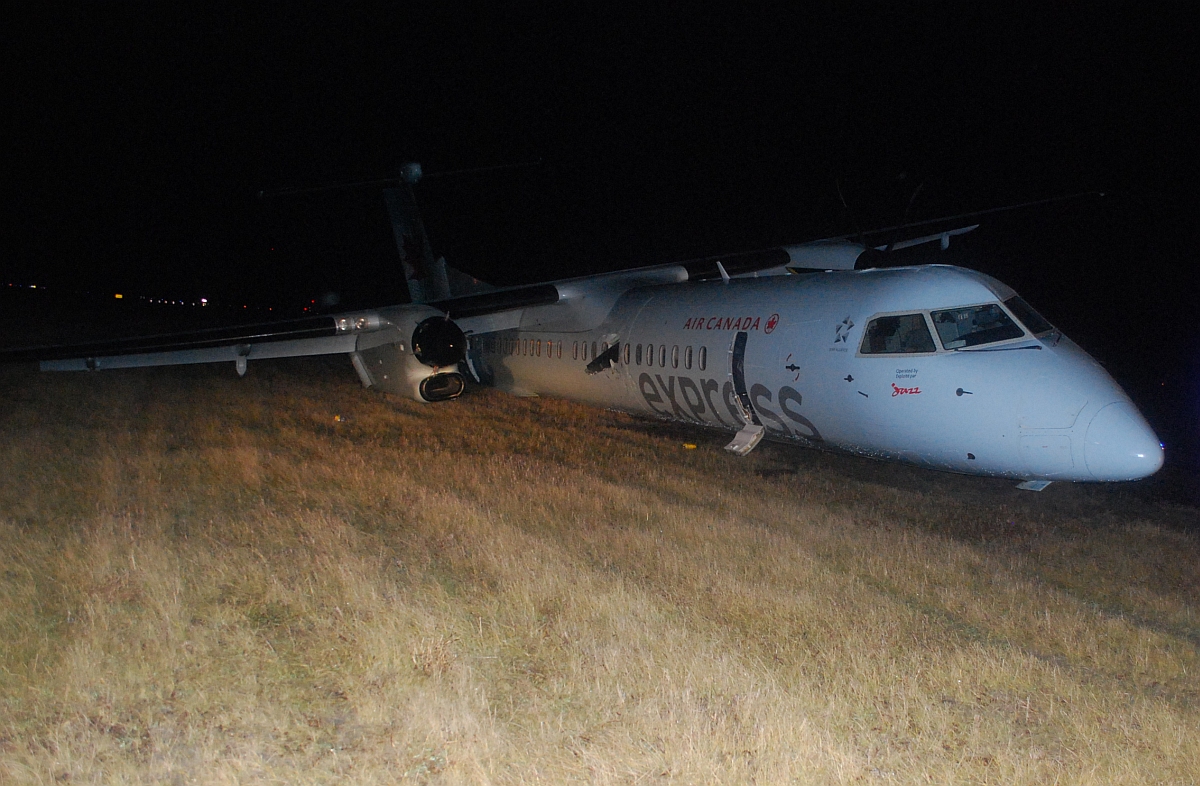Right main landing gear collapse
Jazz Aviation LP (dba Air Canada Express)
DHC-8-402, C-GGBF
Edmonton International Airport
Edmonton, Alberta
The occurrence
The Jazz Aviation LP (doing business as Air Canada Express) Bombardier DHC-8-402, registration C-GGBF, serial number 4433, operating as flight JZA8481, departed from Calgary International Airport (CYYC) with an intended destination of Grande Prairie, Alberta. During the takeoff roll, the number 3 tire of the main landing gear failed. The flight was diverted to Edmonton International Airport (CYEG); aircraft rescue and firefighting equipment was standing by for the landing on Runway 02. On touchdown at 2030 Mountain Standard Time, the right main landing gear collapsed. Upon contact with the ground, all of the right-side propeller blades were sheared, and 1 blade penetrated the cabin wall. The aircraft came to a stop off the right (east) edge of the runway surface. Passengers and crew evacuated using all 4 exits. Three passengers sustained minor injuries. There was no post-accident fire. The accident occurred during the hours of darkness.
Media materials
News release
Excessive vibrations from a failed tire contributed to November 2014 landing gear collapse in Edmonton, Alberta
Read the news release
Deployment notice
TSB deploys a team of investigators to a landing incident at the Edmonton International Airport, Alberta
Edmonton, Alberta, 6 November 2014 - The Transportation Safety Board of Canada (TSB) is deploying a team of investigators to the Edmonton International Airport to assess a landing incident involving a Jazz Dash 8-400 aircraft. The TSB will gather information and assess the occurrence.
Investigation information
Download high-resolution photos from the TSB Flickr page.
Class of investigation
This is a class 3 investigation. These investigations analyze a small number of safety issues, and may result in recommendations. Class 3 investigations are generally completed within 450 days. For more information, see the Policy on Occurrence Classification.
TSB investigation process
There are 3 phases to a TSB investigation
- Field phase: a team of investigators examines the occurrence site and wreckage, interviews witnesses and collects pertinent information.
- Examination and analysis phase: the TSB reviews pertinent records, tests components of the wreckage in the lab, determines the sequence of events and identifies safety deficiencies. When safety deficiencies are suspected or confirmed, the TSB advises the appropriate authority without waiting until publication of the final report.
- Report phase: a confidential draft report is approved by the Board and sent to persons and corporations who are directly concerned by the report. They then have the opportunity to dispute or correct information they believe to be incorrect. The Board considers all representations before approving the final report, which is subsequently released to the public.
For more information, see our Investigation process page.
The TSB is an independent agency that investigates air, marine, pipeline, and rail transportation occurrences. Its sole aim is the advancement of transportation safety. It is not the function of the Board to assign fault or determine civil or criminal liability.
